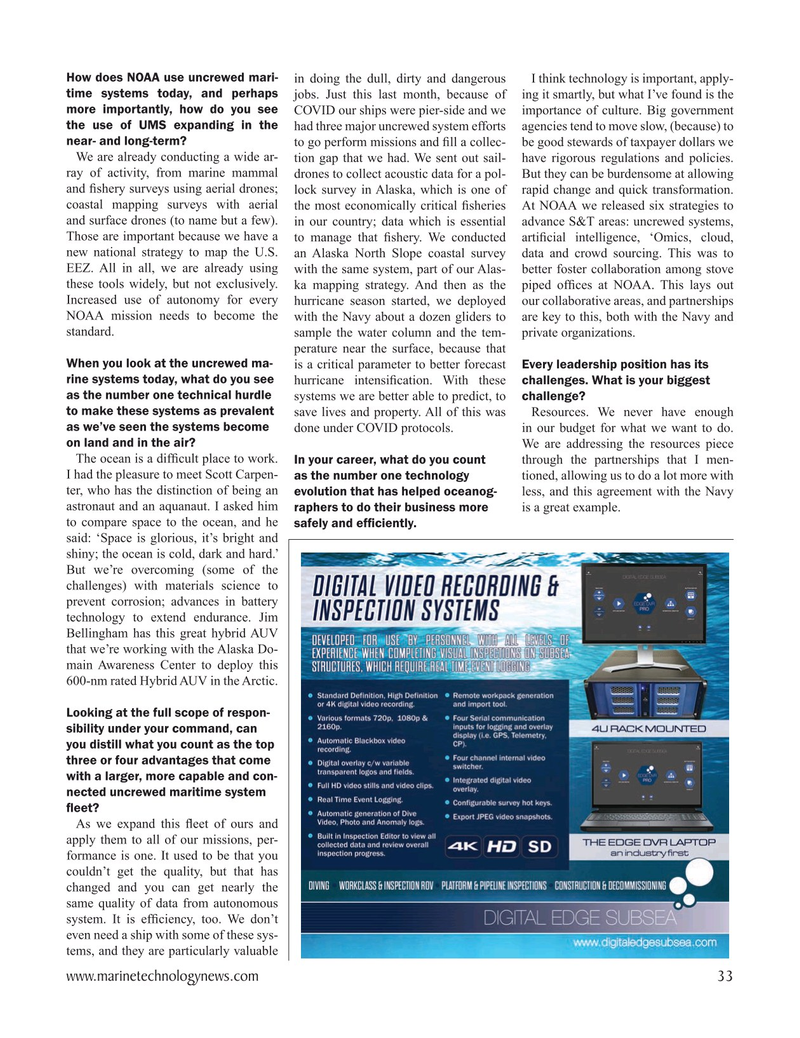
Page 33: of Marine Technology Magazine (September 2020)
Read this page in Pdf, Flash or Html5 edition of September 2020 Marine Technology Magazine
How does NOAA use uncrewed mari- in doing the dull, dirty and dangerous I think technology is important, apply- time systems today, and perhaps jobs. Just this last month, because of ing it smartly, but what I’ve found is the more importantly, how do you see COVID our ships were pier-side and we importance of culture. Big government the use of UMS expanding in the had three major uncrewed system efforts agencies tend to move slow, (because) to near- and long-term? to go perform missions and ? ll a collec- be good stewards of taxpayer dollars we
We are already conducting a wide ar- tion gap that we had. We sent out sail- have rigorous regulations and policies. ray of activity, from marine mammal drones to collect acoustic data for a pol- But they can be burdensome at allowing and ? shery surveys using aerial drones; lock survey in Alaska, which is one of rapid change and quick transformation. coastal mapping surveys with aerial the most economically critical ? sheries At NOAA we released six strategies to and surface drones (to name but a few). in our country; data which is essential advance S&T areas: uncrewed systems,
Those are important because we have a to manage that ? shery. We conducted arti? cial intelligence, ‘Omics, cloud, new national strategy to map the U.S. an Alaska North Slope coastal survey data and crowd sourcing. This was to
EEZ. All in all, we are already using with the same system, part of our Alas- better foster collaboration among stove these tools widely, but not exclusively. ka mapping strategy. And then as the piped of? ces at NOAA. This lays out
Increased use of autonomy for every hurricane season started, we deployed our collaborative areas, and partnerships
NOAA mission needs to become the with the Navy about a dozen gliders to are key to this, both with the Navy and standard. sample the water column and the tem- private organizations.
perature near the surface, because that
When you look at the uncrewed ma- is a critical parameter to better forecast Every leadership position has its rine systems today, what do you see hurricane intensi? cation. With these challenges. What is your biggest as the number one technical hurdle systems we are better able to predict, to challenge?
to make these systems as prevalent save lives and property. All of this was Resources. We never have enough as we’ve seen the systems become done under COVID protocols. in our budget for what we want to do. on land and in the air? We are addressing the resources piece
The ocean is a dif? cult place to work. In your career, what do you count through the partnerships that I men-
I had the pleasure to meet Scott Carpen- as the number one technology tioned, allowing us to do a lot more with ter, who has the distinction of being an evolution that has helped oceanog- less, and this agreement with the Navy astronaut and an aquanaut. I asked him raphers to do their business more is a great example.
to compare space to the ocean, and he safely and ef? ciently.
said: ‘Space is glorious, it’s bright and shiny; the ocean is cold, dark and hard.’
But we’re overcoming (some of the challenges) with materials science to prevent corrosion; advances in battery technology to extend endurance. Jim
Bellingham has this great hybrid AUV that we’re working with the Alaska Do- main Awareness Center to deploy this 600-nm rated Hybrid AUV in the Arctic.
Looking at the full scope of respon- sibility under your command, can you distill what you count as the top three or four advantages that come with a larger, more capable and con- nected uncrewed maritime system ? eet?
As we expand this ? eet of ours and apply them to all of our missions, per- formance is one. It used to be that you couldn’t get the quality, but that has changed and you can get nearly the same quality of data from autonomous system. It is ef? ciency, too. We don’t even need a ship with some of these sys- tems, and they are particularly valuable www.marinetechnologynews.com 33
MTR #7 (18-33).indd 33 9/11/2020 8:48:51 AM

 32
32

 34
34
